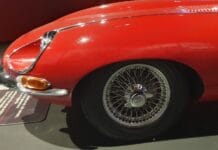Unique does not necessarily mean beautiful. The Goliath Pionier is not necessarily a beautiful car, but it is so unique that it looks like it came straight out of a cartoon. On the other hand, it was a very important and well-loved machine.

Goliath is a long-defunct part of the German Borgward Group. Goliath produced small economy cars and trucks, many of which were three-wheelers. The company was initially founded in 1928 by a businessman and engineer Carl F.W. Borgward. A little later he acquired another company, which became the Borgward Group, which included the Goliath brand.
Borgward presented his first car back in 1924 – it was called the Blitzkarren and was little more than a box with three wheels. But by that time Borgward was in the refrigerator business, so even the modest Blitzkarren was quite an achievement. The Blitzkarren was surprisingly popular and stayed in production until 1927. Borgward then founded Goliath Werke Borgward & Co. GmbH and decided to take car production more seriously.

Those were hard times. Germany was just waking up after losing the First World War a little less than a decade ago. The country was dealing with poverty, but people still needed tools. Borgward completely redesigned his Blitzkarren and in 1921 introduced the Goliath Pionier – the three-wheeler we are talking about here.
Goliath Pionier is a very simple car. At the rear it has a 0.2 or 0.25 liter two-stroke engine, producing 5 or 7 horsepower (4 or 5 kW). It powers the rear wheels through a three-speed transmission. Goliath Pionier could in theory reach 60 kph, but a more realistic top speed was probably around 50 kph. On the other hand, only 5 liters of petrol were needed for a 100 km trip. The chassis was a very simple frame with a leaf spring for each wheel.

The Pionier had a ridiculously simple body – it’s just a wooden frame wrapped in a synthetic leather. Buyers could choose between a closed coupe and a convertible body style. An 8-liter fuel tank was in front of the 2-seater cockpit, while the engine was rattling behind it. This meant that there was no room for luggage. The Pionier had a couple of headlights and wipers, but operating it in the dark and in the rain was quite a scary thing to do.
People really loved the Goliath Pionier. Yes, it was a very simple car, but it was meant to be chea[. At that time, light 3-wheelers in Germany could be driven without a driver’s license. Furthermore, you didn’t have to pay taxes on the Pionier, because it didn’t amount to a car in the eyes of the law.

In the period of 1931-1934, about 4,000 Goliath Pioniers were sold. During that time, a total of about 24,500 light 3-wheelers were sold in Germany, which means that the humble Pionier took a respectable chunk of that market. In later years of production the Pionier became a slightly sleeker hatchback. But as the economy recovered, people wanted better, more practical vehicles. Consequently, the Goliath Pionier was succeeded by a more powerful four-wheeled Hansa 400. Meanwhile the Goliath brand went into truck production.
Only a few Goliath Pioneers have survived to this day. Such cheap cars were not preserved, and the wooden frames succumbed to rot very quickly.




